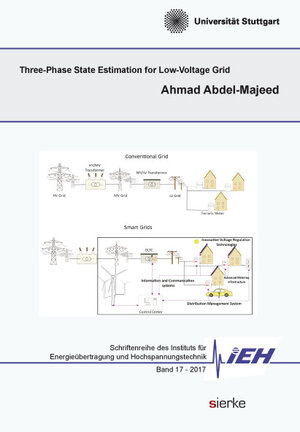
×
![Buchcover ISBN 9783868448931]()
Three-Phase State Estimation for Low-Voltage Grids
von Ahmad Abdel-MajeedThe increased integration of Distributed Generators (DGs), especially the residentialscale photovoltaic (PV) units in the distribution grids, leads to new challenges for Distribution System Operators (DSOs) in terms of overloading of the grid components, particularly at distribution grid levels. There is also an issue regarding the violation of the allowable voltage range, most notably at low voltage (LV) levels. The voltage violation problems can be mitigated either by traditional grid reinforcement measures or by the application of intelligent voltage control strategies. Moreover, these control strategies need to determine the current state of the grid and to predict its response to load and generation changes. One possible tool for that is to perform load flow calculations, which are mainly used for grid analysis and planning. Load flow calculations in LV grids, however, are not suitable for real-time analysis and operation because a very accurate load and generation data set is required for each node. Also, the desired measurement infrastructure is not a viable solution. A more reliable and accurate alternative that should be considered is a State Estimation (SE) algorithm. It has the ability to determine the grid state and condition based on a variety of different measurement data with different accuracies. Taking the characteristics of LV grids into consideration, a computationally efficient, three-phase state estimator is needed. In the above context, the research presented in this thesis investigates different aspects for the topic of SE, especially in LV grids. First, this thesis analyzes different three-phase SE algorithms based on their state variable. The primary focus is to choose a suitable SE method, taking the LV grid’s characteristics into consideration. The performance of the analyzed methods, under the presence of different measurement noises, has been assessed using the Monte-Carlo approach, due to the statistical nature of the measurements. Moreover, some modification is done to the selected method to improve the performance of the algorithm. Second, the error modeling for real-time, pseudo and virtual measurements has been introduced. In addition, different methods for modeling the pseudo-measurements for both load and PV feed-in power based on the availability of Advanced Metering Infrastrucuture (AMI) data has been implemented and tested. The main purpose was to show how the pseudo-measurement’s modeling accuracy can be improved based on the availability of historical AMI data; Using some advanced modeling methods, the accuracy improvement for the pseudo-measurements results in improved SE accuracy too. Third, the meter placement problem has been proposed, and different meter placement schemes have been introduced. These meter placement schemes are strongly focused on reducing the voltage estimation errors and are capable of reducing the error below the desired threshold with a limited number of real-time measurements. The different schemes are applied to a LV grid to examine the correctness of the reached meter placement solution and to examine how effective is the reduction of computational time. Fourth, the optimal SE accuracy for LV grid applications has been explored by applying different voltage control strategies on a LV grid, based on the estimated grid states from different state estimators with different estimation accuracies. The main target is to define criteria to help the DSO to decide which SE accuracy is needed for specific Distribution Management System (DMS) grid applications. Finally, the developed three-phase SE algorithm together with the improved modeling techniques for pseudo-measurements has been employed together to realize a field test for a LV grid. The validation of the algorithm in real-time, in comparison to the offline Monte-Carlo simulations, has been done.


